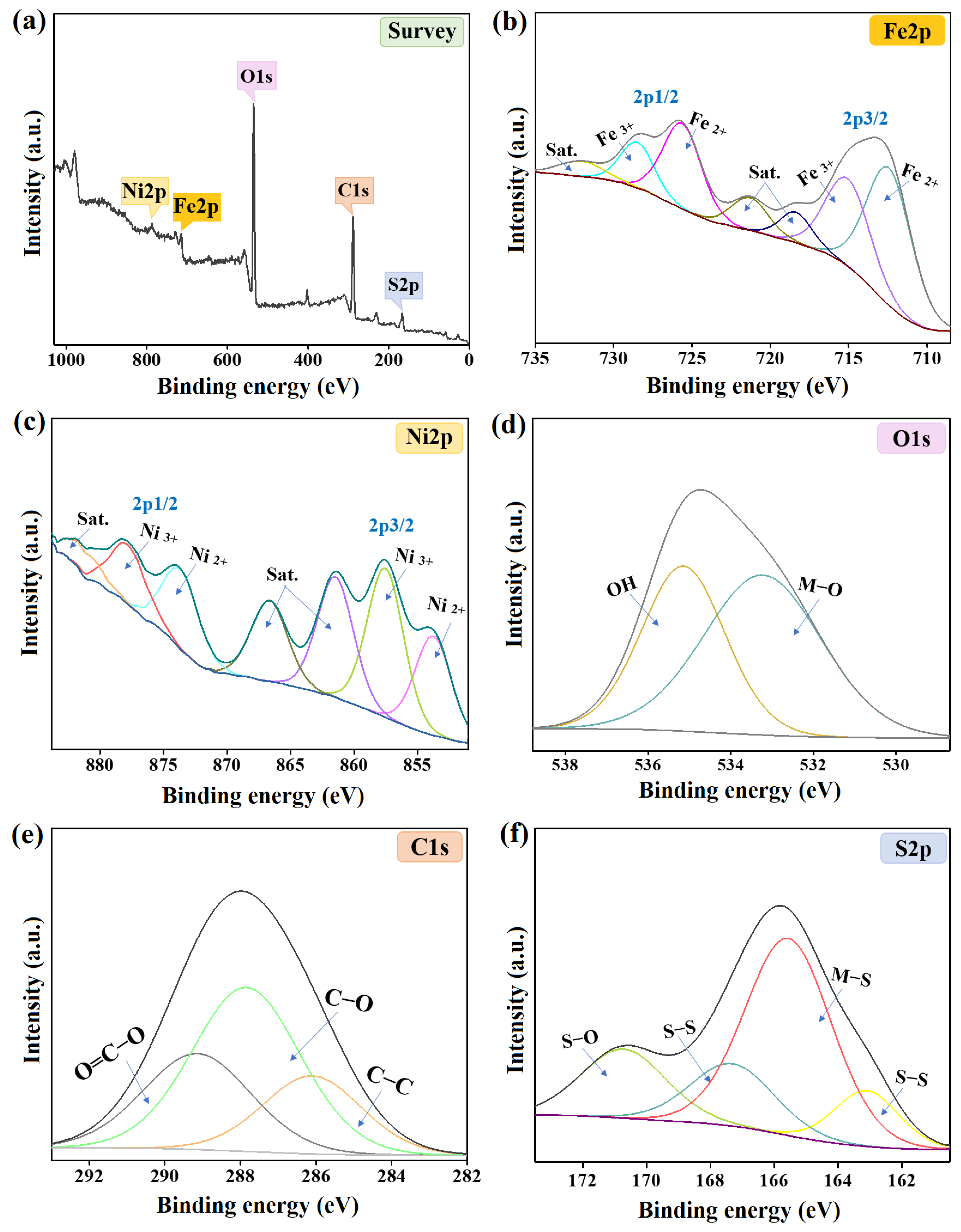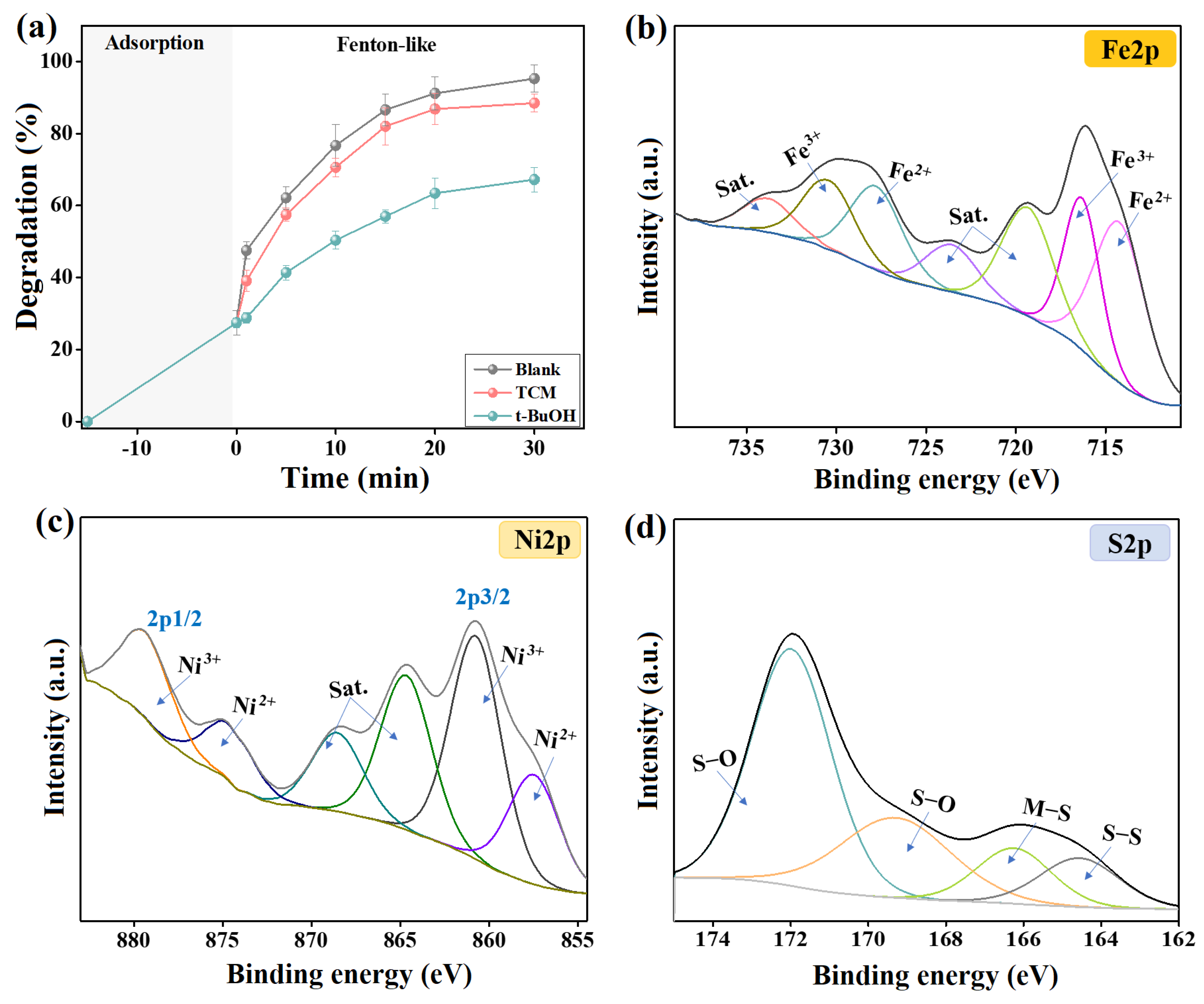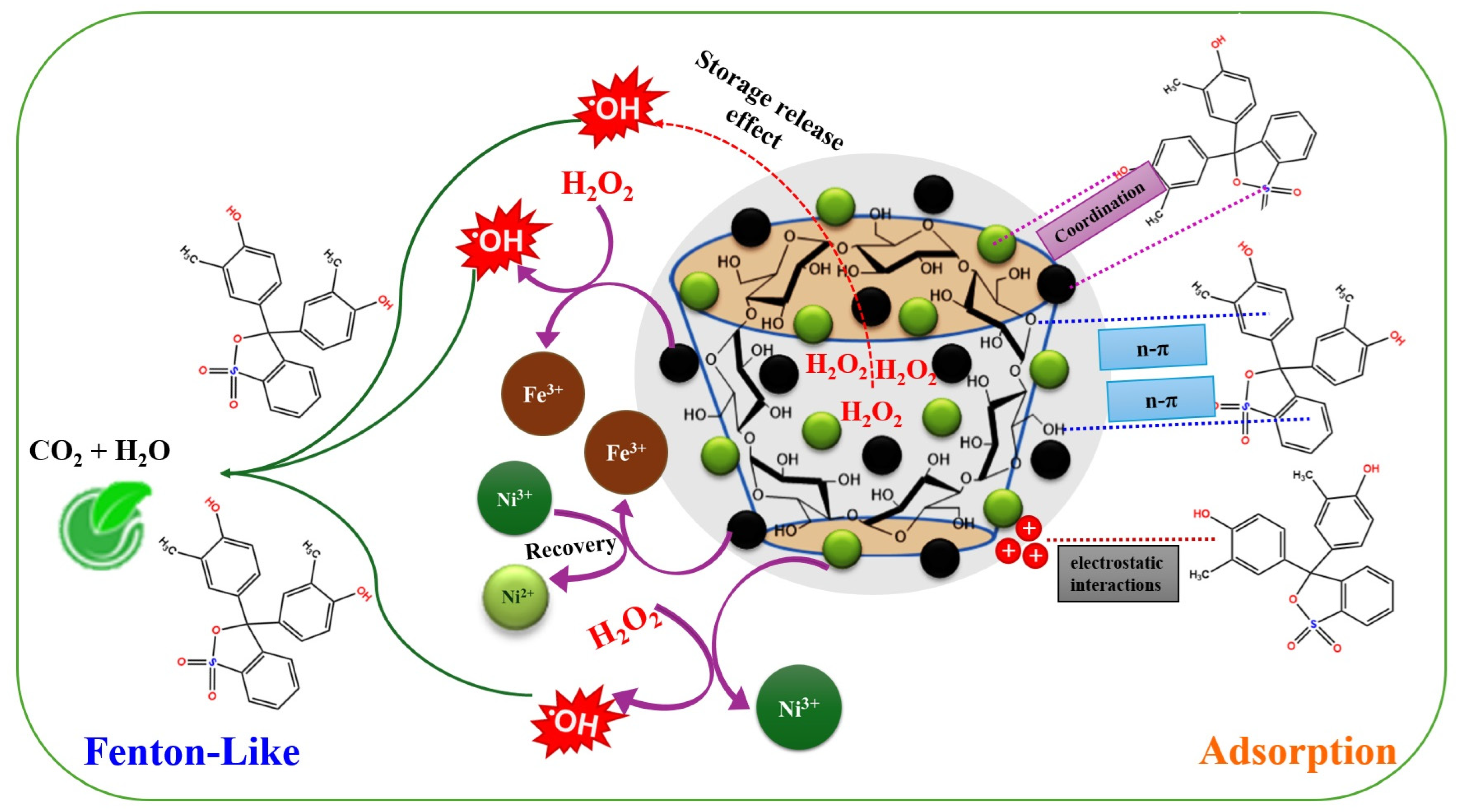Cyclodextrin Polymer-Embedded NiS/FeS Composite as a Fenton-like Catalyst for the Degradation of Cresol Red
Abstract
:1. Introduction
2. Materials and Methods
2.1. Fabricating Nickel Sulfide
2.2. Fabricating Iron Sulfide
2.3. Fabricating NiS/FeS@β-CD Composite
2.4. Characterization Instruments
2.5. Fenton-like Experiments of Degrading the Cresol Red Dye
2.6. Quenching Test
2.7. Durability Study
3. Results and Discussion
3.1. Characterizing the Chemical/Physical Properties of NiS/FeS@β-CD
3.1.1. FTIR
3.1.2. XRD
3.1.3. Zeta Potential
3.1.4. SEM
3.1.5. XPS
3.2. Discussing the Results of the Lab Experiments of Degrading Cresol Red
3.2.1. Investigating the Best Stoichiometric Ratio
3.2.2. Investigating the Optimal pH
3.2.3. Investigating the Ideal Catalyst Dosage
3.2.4. Investigating the Influence of Processing Temperature
3.2.5. Investigating the Optimal H2O2 Concentration/Volume
3.2.6. Investigating the Equilibrium Decomposition Time of H2O2
3.3. Kinetic Investigations
3.4. Quenching Test
3.5. Degradation Mechanism
3.6. Proposed Pathway for Cresol Red Degradation
3.7. Durability Study
4. Conclusions
Supplementary Materials
Author Contributions
Funding
Institutional Review Board Statement
Data Availability Statement
Acknowledgments
Conflicts of Interest
References
- Gou, J.; Xie, S.; Li, Y.; Kong, X.; Li, C. Studies on preparation and performance of nickel sulfides for the application in supercapacitors. J. Mater. Sci. Mater. Electron. 2019, 30, 15429–15436. [Google Scholar]
- Shit, S.; Jang, W.; Bolar, S.; Murmu, N.C.; Koo, H.; Kuila, T. Effect of the solvent ratio (ethylene glycol/water) on the preparation of an iron sulfide electrocatalyst and its activity towards overall water splitting. ChemElectroChem 2019, 6, 3199–3208. [Google Scholar] [CrossRef]
- Yuan, C.; Liu, B.; Liu, H. Characterization of hydroxypropyl-β-cyclodextrins with different substitution patterns via FTIR, GC–MS, and TG–DTA. Carbohydr. Polym. 2015, 118, 36–40. [Google Scholar] [CrossRef] [PubMed]
- Sun, X.; Yang, H.; Zhu, H.; Wang, L.; Fu, Z.; Zhang, Q.; Zhu, H. Synthesis and enhanced supercapacitor performance of carbon self-doping graphitic carbon nitride/NiS electrode material. J. Am. Ceram. Soc. 2021, 104, 1554–1567. [Google Scholar] [CrossRef]
- Nachimuthu, S.; Kannan, K.; Thangavel, S.; Gurushankar, K. Electrochemical and magnetic properties of 3D porous NiS/CuS nanocomposites. Appl. Surf. Sci. Adv. 2022, 7, 100209. [Google Scholar]
- Lo, S.-Y.; Dianbudiyanto, W.; Liu, S.-H. Selective recovery of platinum from spent autocatalyst solution by thiourea modified magnetic biocarbons. Sci. Rep. 2021, 11, 19281. [Google Scholar] [CrossRef]
- Min, X.; Li, Y.; Ke, Y.; Shi, M.; Chai, L.; Xue, K. Fe-FeS2 adsorbent prepared with iron powder and pyrite by facile ball milling and its application for arsenic removal. Water Sci. Technol. 2017, 76, 192–200. [Google Scholar] [CrossRef]
- Agoro, M.A.; EMeyer, L. FeS/FeS2 nanoscale structures synthesized in one step from Fe (ll) dithiocarbamate complexes as a single source precursor. Front. Chem. 2022, 10, 1035594. [Google Scholar] [CrossRef]
- Danu, B.Y.; Agorku, E.S.; Ampong, F.K.; Awudza, J.A.M.; Torve, V.; Danquah, I.M.K.; Ama, O.M.; Osifo, P.O.; Ray, S.S. Iron sulfide functionalized polyaniline nanocomposite for the removal of Eosin Y from water: Equilibrium and kinetic studies. Polym. Sci. Ser. B 2021, 63, 304–313. [Google Scholar]
- Sadaquat, H.; Akhtar, M. Comparative effects of β-cyclodextrin, HP-β-cyclodextrin and SBE 7-β-cyclodextrin on the solubility and dissolution of docetaxel via inclusion complexation. J. Incl. Phenom. Macrocycl. Chem. 2020, 96, 333–351. [Google Scholar] [CrossRef]
- Hao, J.; Gao, Y.; Zheng, C.; Liu, J.; Hu, J.; Ju, Y. Natural-Product-Tailored Polyurethane: Size-Dictated Construction of Polypseudorotaxanes with Cyclodextrin–Triterpenoid Pairs. ACS Macro Lett. 2018, 7, 1131–1137. [Google Scholar] [PubMed]
- Zhang, Y.; Yuan, H.; Liu, Z.; Wang, C.; Kong, W.; Xu, L.; Sun, Y.; Zhang, M.; Tan, S. High performance microwave absorption in nickel sulfide nanospheres. J. Mater. Sci. Mater. Electron. 2023, 34, 1328. [Google Scholar]
- Ma, Z.; Yuan, X.; Zhang, Z.; Mei, D.; Li, L.; Ma, Z.-F.; Zhang, L.; Yang, J. Novel flower-like nickel sulfide as an efficient electrocatalyst for non-aqueous lithium-air batteries. Sci. Rep. 2015, 5, 18199. [Google Scholar]
- Kristl, M.; Dojer, B.; Gyergyek, S.; Kristl, J. Synthesis of nickel and cobalt sulfide nanoparticles using a low cost sonochemical method. Heliyon 2017, 3, e00273. [Google Scholar] [PubMed]
- Gao, S.; Brown, B.; Young, D.; Singer, M. Formation of iron oxide and iron sulfide at high temperature and their effects on corrosion. Corros. Sci. 2018, 135, 167–176. [Google Scholar]
- Yang, Y.; Peng, K.; Deng, Y.; Zhao, Y.; Ai, J.; Min, X.; Hu, M.; Huang, S.; Yu, L. The synthesis of nickel sulfide deposited with nitrogen-doped carbon quantum dots as advanced electrode materials for supercapacitors. J. Mater. Sci. 2022, 57, 14052–14064. [Google Scholar]
- Yang, L.; Hong, W.; Zhang, Y.; Tian, Y.; Gao, X.; Zhu, Y.; Zou, G.; Hou, H.; Ji, X. Hierarchical NiS2 modified with bifunctional carbon for enhanced potassiumion storage. Adv. Funct. Mater. 2019, 29, 1903454. [Google Scholar]
- Wang, B.; Huang, H.; Sun, T.; Yan, P.; Isimjan, T.T.; Tian, J.; Yang, X. Dissolution reconstruction of electron-transfer enhanced hierarchical NiSx-MoO2 nanosponges as a promising industrialized hydrogen evolution catalyst beyond Pt/C. J. Colloid Interface Sci. 2020, 567, 339–346. [Google Scholar]
- Bai, R.; Yan, W.; Xiao, Y.; Wang, S.; Tian, X.; Li, J.; Xiao, X.; Lu, X.; Zhao, F. Acceleration of peroxymonosulfate decomposition by a magnetic MoS2/CuFe2O4 heterogeneous catalyst for rapid degradation of fluoxetine. Chem. Eng. J. 2020, 397, 125501. [Google Scholar]
- Eltaweil, A.S.; Al Harby, N.; Osman, A.I.; Alrasheedi, M.; Su, Y.; Abd El-Monaem, E.M. Engineering of a wafer-shaped titanium-based catalyst of TiO2/MIL-125 (Ti)@ Ti3C2 for enhanced Fenton-like degradation of Congo red: Optimization, mechanistic study, and reusability. J. Ind. Eng. Chem. 2025, 143, 704–716. [Google Scholar]
- Abd El-Monaem, E.M.; Omer, A.M.; Heydari, A.; Ouyang, X.K.; El-Subruiti, G.M.; Xiao, Y.; Eltaweil, A.S. Harnessing the storage-release cavity of β-cyclodextrin to enhance SnFe2O4/FeCoNi-LTH catalyst efficiency in fenton-like degradation of tetracycline. Surf. Interfaces 2025, 58, 105749. [Google Scholar] [CrossRef]
- Shen, Y.; Zhou, Y.; Zhang, Z.; Xiao, K. Cobalt–copper oxalate nanofibers mediated Fenton degradation of Congo red in aqueous solutions. J. Ind. Eng. Chem. 2017, 52, 153–161. [Google Scholar] [CrossRef]
- Aljeboree, A.M.; Alkaim, A.F.; Al-Dujaili, A.H. Adsorption isotherm, kinetic modeling and thermodynamics of crystal violet dye on coconut husk-based activated carbon. Desalination Water Treat. 2015, 53, 3656–3667. [Google Scholar]
- Mashkoor, F.; Nasar, A.; Inamuddin; Asiri, A.M. Exploring the reusability of synthetically contaminated wastewater containing crystal violet dye using tectona grandis sawdust as a very low-cost adsorbent. Sci. Rep. 2018, 8, 8314. [Google Scholar]
- Abd El-Monaem, E.M.; Al Harby, N.; El Batouti, M.; Eltaweil, A.S. Enhanced redox cycle of rod-shaped MIL-88A/SnFe2O4@ MXene sheets for Fenton-like degradation of Congo Red: Optimization and mechanism. Nanomaterials 2023, 14, 54. [Google Scholar]
- Sun, C.; Yang, S.-T.; Gao, Z.; Yang, S.; Yilihamu, A.; Ma, Q.; Zhao, R.-S.; Xue, F. Fe3O4/TiO2/reduced graphene oxide composites as highly efficient Fenton-like catalyst for the decoloration of methylene blue. Mater. Chem. Phys. 2019, 223, 751–757. [Google Scholar]
- Geng, T.; Yan, J.; Li, B.; Yan, H.; Guo, L.; Sun, Q.; Guan, Z.; Zhao, C.; Xu, J.; Wang, W. Efficient degradation of methylene blue at near neutral pH based on heterogeneous Fenton-like system catalyzed by Fe2O3/MnO2. Results Chem. 2024, 11, 101795. [Google Scholar] [CrossRef]
- Singh, J.; Yang, J.-K.; Chang, Y.-Y.; Koduru, J.R. Fenton-Like degradation of methylene blue by ultrasonically dispersed nano zero-valent metals. Env. Process 2017, 4, 169–182. [Google Scholar]
- Karim, M.; Aziz, K.H.H.; Omer, K.M.; Salih, Y.M.; Mustafa, F.; O Rahman, K.; Mohammad, Y. Degradation of aqueous organic dye pollutants by heterogeneous photo-assisted Fenton-like process using natural mineral activator: Parameter optimization and degradation kinetics. In IOP Conference Series: Earth and Environmental Science, Volume 958, Proceedings of the 7th International Conference on Water Resource and Environment (WRE 2021), Xi’an, China, 1–4 November 2021; IOP Publishing: Bristol, UK, 2021. [Google Scholar]
- Farooq, U.; Danish, M.; Lu, S.; Naqvi, M.; Gu, X.; Fu, X.; Zhang, X. Synthesis of nZVI@ reduced graphene oxide: An efficient catalyst for degradation of 1, 1, 1-trichloroethane (TCA) in percarbonate system. Res. Chem. Intermed. 2017, 43, 3219–3236. [Google Scholar] [CrossRef]
- Zhang, S.Q.; Xu, H.Y.; Li, B.; Xu, Y.; Komarneni, S. Constructing a Z-Scheme Co3O4/BiOBr Heterojunction to Enhance Photocatalytic Peroxydisulfate Oxidation of High-Concentration Rhodamine B: Mechanism, Degradation Pathways, and Toxicological Evaluations. Inorg. Chem. 2024, 63, 4447–4460. [Google Scholar] [CrossRef]
- Abd El-Monaem, E.M.; Omer, A.M.; Eltaweil, A.S. Durable and low-cost Chitosan decorated Fe/MOF-5 bimetallic MOF composite film for high performance of the Congo red adsorption. J. Polym. Environ. 2024, 32, 2075–2090. [Google Scholar]
- Olusegun, S.J.; Mohallem, N.D.; Ciminelli, V.S. Reducing the negative impact of ceftriaxone and doxycycline in aqueous solutions using ferrihydrite/plant-based composites: Mechanism pathway. Environ. Sci. Pollut. Res. 2022, 29, 66547–66561. [Google Scholar]
- Wang, X.; Liu, W.; Qin, J.; Lei, L. Improvement of H2O2 utilization by the persistent heterogeneous Fenton reaction with the Fe3O4-zeolite-cyclodextrin composite. Ind. Eng. Chem. Res. 2020, 59, 2192–2202. [Google Scholar] [CrossRef]
- Fishman, A.; Tao, Y.; Wood, T.K. Toluene 3-monooxygenase of Ralstonia pickettii PKO1 is a para-hydroxylating enzyme. J. Bacteriol. 2004, 186, 3117–3123. [Google Scholar] [CrossRef]










| Kinetic Model | CR Concentrations (mg/L) | |||
| 50 | 100 | 200 | 300 | |
| First order | ||||
| k1 | 0.0972 | 0.0416 | 0.0291 | 0.0153 |
| R2 | 0.972 | 0.937 | 0.904 | 0.833 |
| Second order | ||||
| k2 | 0.5579 | 0.1335 | 0.0508 | 0.0181 |
| R2 | 0.917 | 0.985 | 0.969 | 0.899 |
Disclaimer/Publisher’s Note: The statements, opinions and data contained in all publications are solely those of the individual author(s) and contributor(s) and not of MDPI and/or the editor(s). MDPI and/or the editor(s) disclaim responsibility for any injury to people or property resulting from any ideas, methods, instructions or products referred to in the content. |
© 2025 by the authors. Licensee MDPI, Basel, Switzerland. This article is an open access article distributed under the terms and conditions of the Creative Commons Attribution (CC BY) license (https://creativecommons.org/licenses/by/4.0/).
Share and Cite
Abd El-Monaem, E.M.; Al Nawah, J.Y.; Ayoup, M.S.; Eltaweil, A.S. Cyclodextrin Polymer-Embedded NiS/FeS Composite as a Fenton-like Catalyst for the Degradation of Cresol Red. Polymers 2025, 17, 876. https://doi.org/10.3390/polym17070876
Abd El-Monaem EM, Al Nawah JY, Ayoup MS, Eltaweil AS. Cyclodextrin Polymer-Embedded NiS/FeS Composite as a Fenton-like Catalyst for the Degradation of Cresol Red. Polymers. 2025; 17(7):876. https://doi.org/10.3390/polym17070876
Chicago/Turabian StyleAbd El-Monaem, Eman M., Jawaher Y. Al Nawah, Mohammed Salah Ayoup, and Abdelazeem S. Eltaweil. 2025. "Cyclodextrin Polymer-Embedded NiS/FeS Composite as a Fenton-like Catalyst for the Degradation of Cresol Red" Polymers 17, no. 7: 876. https://doi.org/10.3390/polym17070876
APA StyleAbd El-Monaem, E. M., Al Nawah, J. Y., Ayoup, M. S., & Eltaweil, A. S. (2025). Cyclodextrin Polymer-Embedded NiS/FeS Composite as a Fenton-like Catalyst for the Degradation of Cresol Red. Polymers, 17(7), 876. https://doi.org/10.3390/polym17070876







